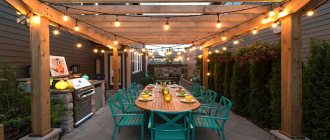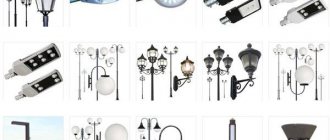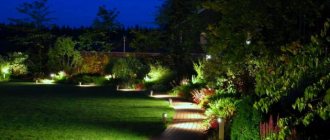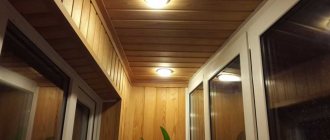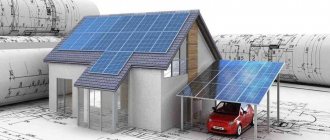To ensure sufficient visibility in the open part of the adjacent territory of enterprises, private houses and cottages, external lighting is installed. Despite the widespread implementation of measures aimed at reducing the costs of ensuring visibility in open areas, electricity costs still add up to significant amounts. Therefore, a relevant way to reduce electrical energy consumption is solar-powered street lighting. Such installations are increasingly replacing classical models, as they have a number of operational advantages.
Advantages and disadvantages
Installing lighting for a yard, garden, or local area is expensive - you not only need to install lamps, but also lay cables. Underground cable laying is more reliable, which means a large amount of excavation work, plus significant costs for the cable, since it must be in a protective sheath, or better yet, armored. But that’s not all - during operation you have to pay hefty electricity bills - the lighting works every day, for 6-8 hours. Solar-powered street lighting can partially solve the problem.
Such lighting can be done using ordinary lamps and a cable stretched between them, or by installing solar-powered lamps
Advantages
Why partially? Because the most “critical” areas (gates, parking, entrance doors) will have to be illuminated permanently - it’s more reliable. But on the rest of the area you can install solar-powered lamps. They have a number of advantages.
- Solar-powered lamps are usually self-contained and do not need to be connected anywhere. They are installed/hung in the right places, the installation is completed, they are ready for work.
- They turn on/off themselves, from the built-in sensors. Ease of installation and safety are two big advantages
- They require minimal maintenance - you need to periodically wipe the photocells and lampshade from dust and dirt.
- They have a long service life - from 10 years or more (with proper quality).
- They do not harm the environment and are absolutely safe, as they operate on low voltage, which is not dangerous to humans.
- If solar-powered street lighting is made in a country house, preserving it for the winter and installing it takes very little time. You just need to collect the lamps before leaving and arrange them upon arrival.
Flaws
As you can see, there are many advantages, the main one being energy savings and very simple installation/dismantling. But there are also disadvantages:
- Solar-powered garden and street lamps usually produce not very bright light. They cannot be used as security lighting. More precisely, there are powerful models that are even used for lighting highways, but their cost is completely inhumane, which is why their use in private backyards is very limited. Solar street lighting is usually not very bright
- The number of operating hours at night depends on the weather: in cloudy, rainy weather, the lamps “store” too little energy. Sometimes it only lasts for a few hours, and not for the whole night.
- Reliable solar-powered lamps are expensive, but they work more reliably and longer.
- Solar panels have a limited operating temperature range. They do not tolerate severe frosts and extreme heat. Therefore, they can be optimally used in areas with a temperate climate.
As you can see, the option is not ideal, but it really helps to save on electricity, because standard lighting of critical areas is far from half the cost of general lighting of the yard and garden.
Battery type and capacity
Solar lamps usually use nickel-cadmium batteries , which have proven themselves quite well. Nickel-metal hydride are used less often - they last longer, but are also more expensive.
If LEDs are designed for 60,000 hours of operation, then the battery is a more delicate part of the lamp. A high-quality battery needs to be replaced approximately every 10 years. If you decide to save money and buy a cheaper flashlight, then there is a high probability that the first battery replacement will have to be done in 1-1.5 years.
Also pay attention to battery capacity , although some manufacturers do not indicate it. All other things being equal, it is better to choose a product with a more capacious battery - such a lamp will be able to accumulate more energy and shine longer at night. However, in order for the battery to be fully charged, you need to install the product in an area with maximum natural light.
Features of the design and operation of lamps
There are many types of solar-powered lighting devices, but their design and operating principle of light panels are approximately the same. Solar energy is accumulated using special batteries and accumulators.
When power is applied to a semiconductor LED, it emits visible light. The LED control system consists of a light sensor and a microcircuit.
Due to the peculiarities of their design, the lamps can operate in both summer and autumn. Depending on the season and the degree of illumination, they turn on from approximately 6 to 9-10 pm (+)
The intensity of the lantern's glow depends on the voltage. When the battery is low, the control system turns off the light. It is turned on using a special photocell, the function of which is to convert solar energy into electrical energy.
Installing powerful models is not always convenient. In many cases, it is better to select low-power lamps and install them closer to the ground. This will allow you to save on equipment, and the quality of path lighting will not decrease
When choosing lamps, you should take into account not only the technical characteristics of the devices themselves, but also the climatic features of the area. Batteries cannot withstand frost, so in regions where severe winters are possible, the lanterns are dismantled in late autumn and returned to their place only in the spring.
In late autumn, when daylight hours are short and the weather is often cloudy, the batteries of solar-powered lanterns are rarely fully charged. However, the energy is enough for several hours of illumination in the evening.
Most models have photocells made from silicon. This is an important nuance, because... devices based on monocrystalline silicon are more reliable and durable than models with polycrystalline photocells.
They also pay attention to the type and quality of glass. The best choice is flashlights with polycrystalline photocells and tempered glass.
Varieties
There are many types of street lamps powered by solar panels. Among them are the main designs:
- wall;
- park;
- lawn;
- decorative.
When choosing the type of lamp, it is important to take into account, in addition to the technical characteristics of the devices themselves, the climatic conditions of the area where they will be used.
We must remember that autonomous solar-powered lighting cannot do without batteries. In those regions where severe frosts are quite possible, it is necessary for this period either to dismantle the lamps until spring, or to ensure their operation in such a way that the operation of the storage elements is protected from the influence of low temperatures.
In all other respects, such lighting can be used anywhere in a summer cottage and country houses. Moreover, the light elements themselves can be an excellent addition to the design of the landscape.
Of course, you must always remember that these light sources use energy from the sun. This means they need to be placed in such a way that they receive as much sunlight as possible. If the solar cells are directly exposed to the sun's rays at least 12 hours a day, reliable operation of the lanterns will be ensured.
And then, in principle, any modification of a street lighting device will become useful and functional.
Main selection criteria
External equipment and solar lighting fixtures themselves can be divided into two types:
- lamps for the garden and adjacent areas, which mainly serve for decoration and illuminate a small area of the area around them with their light;
- outdoor LED lamps, which are primarily needed for the best possible illumination of the entire local area. And only then can they be used as landscape lighting.
Outwardly, they are quite similar, but the tasks they perform are completely different.
Street lighting requires more reliable and powerful lighting devices.
But now we have reached the cost stage.
For private summer cottages, inexpensive models of lighting devices powered by cheap batteries were used. They used up their resources quite quickly.
Street lighting on poles requires a different approach. More powerful nickel-cadmium batteries are required that can last for a long time. Other light bulbs are also needed. LED lamps have a lifespan of 30–60 thousand hours.
The durability of the entire complex of street lamps is also affected by the quality of the solar panels themselves, which must have protection against mechanical damage with a long service life.
If you create a powerful (10–15 W) lamp with a motion sensor, this will be enough to comfortably illuminate the space around the house.
And only in this case you get the opportunity to get the highest quality lighting of the entire local area.
Where can I buy
You can purchase solar panels either in a specialized store or online in an online store. In the second case, the budget option for purchasing products on the Aliexpress website deserves special attention. For some panels there is an option for shipment from a warehouse in the Russian Federation; they can be received as quickly as possible; to do this, when ordering, select “Delivery from the Russian Federation”:
| LED Solar Pendant Lamp | LED lamp with solar battery and motion sensor | Solar LED street lamp |
| Dokio Portable Solar Panel 18V 200W | Outdoor LED solar lamps, with sensor, 270 | Solar Powered Outdoor Wall Lamp |
Debunking myths about solar lanterns
Opponents of solar-powered lamps for street lighting argue that such devices cannot compete with electric lamps. But does it make sense to compare them at all? They are originally designed for different purposes.
Comparing electric lamps and solar-powered lanterns is incorrect. They give completely different light. The first ones are bright and sharp, the second ones are muted and soft.
The purpose of electric lamps is to provide bright contrasting light, thanks to which you can see all the details. But solar-powered lanterns have a completely different function - to illuminate the area so that you can navigate normally in the evening and at night.
They are not intended to illuminate areas where active activities requiring attention and precision are planned.
Solar-powered lanterns should not be considered an adequate alternative to electric ones. They highlight and decorate the area, create an atmosphere of calm and romance, but are not able to create areas of bright light
Flashlights based on photocells cannot compete with electrical devices in terms of brightness, so it makes sense to organize combined lighting.
For example, an electric lamp is appropriate above the porch of a house. To increase ease of use and save energy, it can be supplemented with a motion sensor or photosensitive relay. And paths, lawns, and gardens can be illuminated with solar-powered lamps.
When arranging a combined system, you need to remember that the electric light blocks the solar lights.
Combined lighting will be successful if electric and solar lamps illuminate different areas and do not overlap each other. By choosing the right devices in terms of brightness and color, you can organize smooth transitions
The intensity and duration of operation of autonomous solar street lights largely depends on the weather.
If it is cloudy during the day, you cannot expect good and long-lasting light in the evening, because... To fully charge the battery, it takes 8-10 hours and good sunlight. This is the main disadvantage of photocell street lights.
Why pay money for street lighting?
In recent years, you can see street lamps not only near private houses, shops, cafes, offices, but also in dachas, where the owners appear from time to time and for a short time.
It would seem, why invest money in lighting where the owners visit only occasionally? But it makes sense.
Multi-colored solar-powered lamps are used to decorate individual areas - artificial ponds, verandas, gazebos, etc. They create exceptionally beautiful and unique color and light effects.
A dacha is a place where people come to relax, enjoy peace and the company of family and friends. It should be cozy and beautiful here.
In addition, lighting in the country is a definite signal for intruders. It indicates that the house is not abandoned and the owners may be in it.
Image gallery
Photo from
Street lighting near the entrance to the building
Romantic evening garden atmosphere
Garden lights along the path
Lamps with photocells at the dacha
Street lighting is vital. In any case, it will have to be equipped. The only question is the amount that will have to be invested for its organization and operation.
The most profitable option is to buy solar-powered street lights. They do not increase your energy bills and do not require any special maintenance.
Top models
All models of street lamps were tested in Russia and some users left reviews about electrical appliances.
Novotech Solar black
The solar panel wall lantern is designed to be installed on horizontal or vertical surfaces. The shape is in the form of a rectangular panel, the mounting bracket is attached to the body with wings to adjust the position of the lamp.
Production characteristics:
- Novotech (Hungary).
- Collection – Solar.
- Height: 151 mm (15.1 cm).
- Width: 115 mm (11.5 cm).
- Length: 163 mm (16.3 cm).
Specifications:
- The power of the lamp unit is 12.4 W.
- Total power – 12.4 W.
- Color – black and white.
- The material of the lampshades and fittings is plastic.
The warranty period is 12 months. The average price is 3,400 rubles.
Ever Brite Solar Motion
Black plastic street lamp for home and garden. There is a motion sensor, holes are made in the case for mounting on the wall.
Specifications:
- The estimated lighting area is 10 m².
- Dust and moisture protection degree – IP55.
- Number of LEDs – 4.
- Lamp color – black
- Light flux – 120 lm.
- Voltage – 12 V.
Cons: due to the use of plastic, the model cannot be left in the sun for a long time - it may fail due to overheating of the batteries.
Warranty – 12 months. The average price is 400 rubles.
LIKES 30 LED
A small flashlight with a motion sensor and a high-capacity battery. Assembled in a compact case, it will work for a long time when installed near the house or on the site.
Specifications:
- Number of lamps – 30.
- Maximum lamp power is 6 W.
- The lampshade material is plastic (ABS).
- Battery parameters – 3.7 V, 1200 mAh.
- Battery type – lithium-ion.
- Black color.
- Case dimensions: 124 x 96 x 68 mm.
Pros: small size, can be carried with you. Hanging on a horizontal surface takes 5-10 minutes. Shines brightly. The case is protected from moisture.
Cons: The plastic body gets very hot in the sun.
The warranty period is 12 months. The average cost is 1000 rubles.
Oasis Light ST9079
Street lamp, the body consists of a plastic lampshade and metal fittings. Small size and high power make the electrical device universal.
Characteristics:
- Type of lamps – LED.
- Number of lamps – 1.
- Voltage – 3.7 V.
- Light flux – 100 lm.
- Total power – 13 W.
- The maximum lamp power is 13 W.
- Protection type – IP44. Additional hidden wiring connection is possible.
Pros: small size, high brightness.
Cons: fragile body.
The warranty period is 12 months. The average price is 2700 rubles.
Novotech Solar 358019
Powerful stationary lamp for mounting on a vertical plane. A large lampshade and a bright light source will well illuminate the space in the garden.
Characteristics:
- Material: plastic.
- Lighting source type – LED.
- Degree of protection – IP54.
- Rated voltage – 3.7 V.
- Width – 161 mm.
- Height – 90 mm.
- Length – 214 mm.
- Number of lamps – 1.
- Lamp power – 12 W.
- Total power – 12.1 W.
- Light temperature – 6000K.
- Lighting area – 3 cubic meters.
- Base color – black.
Pros: shines brightly, convenient mounting, clear response of the motion sensor.
Cons: the plastic case may burst in the cold.
Warranty period – 1 year. The average cost is 6200 rubles.
SOLAR 33372
An original lamp in the shape of a white dog holding an antique lantern. Designed for installation on a horizontal surface.
Characteristics:
- Type of lamps – LED.
- Number of lampshades – 1.
- The fittings are plastic.
- The lampshade material is plastic.
- Height – 25 cm.
- Length – 15.5 cm.
- Width – 23.5 cm.
- Power – 0.06 W.
- Rated voltage – 3.2 V.
- Base type – E27.
- Dust and moisture protection type – IP44.
Pros: an original decoration for a gazebo or veranda.
Cons: no motion sensor.
Warranty – 1 year. The average price is 2400 rubles.
Installation of a solar-powered lamp
Solar-powered street lamps can have different shapes, appearances, and installation methods, but they all consist of a certain set of elements:
- Solar panel or battery. A device that converts solar energy into electrical energy. It may be located on different parts of the lamp, but it is turned upward to better capture the sun's rays.
- Battery. Electrical energy accumulates in it during daylight hours.
Installation of a solar-powered lamp - Lighting block. This is usually a housing, an LED lamp and a lampshade.
- A controller that turns on/off the power supply to the lighting unit.
- Mounting/hanging mount.
As you understand, the principle of operation is this: during daylight hours, the sun's rays are captured by the solar panel, where they are converted into electrical energy and transmitted to the battery. When twilight sets in (illuminance 20 Lux), the controller turns on the power supply and the LED lamp lights up. In the morning at dawn (at illumination of 10 Lux) the lighting is turned off.
Power
The power of garden lamps is usually 3 W. This is enough to create soft light and a special mood. Such devices cannot be an independent source of light. Outdoor lamps for a country house have a power of about 10 W, which is approximately equivalent to 100 W of an incandescent lamp. Such products can already be used to independently illuminate the area.
It is also worth paying attention to the number of LED lamps. The more there are, the more light the lamp will give.
Selection of solar-powered street lighting fixtures
In the retail chain there are LED street lamps with a very wide range of prices - from one hundred rubles to tens of thousands. Sometimes there are models that look almost the same, but are very different in price. How do we understand this and how to choose lighting fixtures for solar-powered street lighting? It's simple - you just need to look at the technical specifications. They make all the difference.
Power
When arranging lighting, it is necessary to consider how much light the lamp can produce. The number of lamps and the distance at which they need to be installed from each other depend on this. Technical specifications usually indicate power in watts, but in the case of LED lamps, this does not mean much.
An example of the technical characteristics of a solar street lamp
To understand the level of illumination, you can compare it with an analogue of a conventional incandescent lamp - their power is more or less clear to us, and you can also convert this indicator into Lums (Lm) - a unit of measurement of illumination. This way you can really evaluate how effective this particular lamp will be.
Table of correspondence between LED lamp power and illumination
As you understand, models with a power of 1 W do not provide much light - about the same as a 20 W incandescent lamp, so they can only be used for illumination or marking an area - marking paths, illuminating gazebos, etc.
Protection class and housing material
In order for solar-powered street lighting to work for a long time and reliably, it is necessary that the housing and the light block (shade) be protected from dust and moisture. It is desirable that the protection class be at least IP44 (more numbers are good, less numbers are bad).
Decoding the numbers in the protection class
It is also worth paying attention to the material from which the lamps are made. Usually this is a special impact-resistant plastic or metal. If the “metal” is other than stainless steel or aluminum, it is better to give preference to plastics. They definitely do not rust and retain their good appearance for a long time.
Type and method of installation
Based on the installation method, LED street lamps are divided into several groups:
- Installation in the ground. This is a group of lamps on legs of different heights - from 20-30 cm to a meter and above. Their installation is extremely simple - they are simply stuck into the ground in the right place.
The most extensive group - lamps are simply stuck into the ground - Pole lamps. As a rule, these are taller models with a leg height of 1.5 meters and above. They can also be installed on the ground, but require more serious installation measures - they have a greater height and weight. You will have to make a hole, insert a post into it, fill it with soil and compact it. There are models for installation on hard surfaces - tiles, asphalt, etc.
Solar lights on high poles - Solar wall lights. There are different styles - from the classic “lantern” design to models in a modern style. Can be mounted on a wall, fence, fence posts.
Wall options look decorative - Hanging. There are also many options - there are models that can be attached to the ceiling, beam, etc., and others that can be hung on branches.
For different purposes and conditions - Built into the ground, paths, stairs. Very practical models that allow you to illuminate even stairs, and they illuminate not from above, as usual, but at the level of the steps. An interesting and practical solution - with this option, the light does not blind the eyes, and the illumination remains good. Staircase lighting - convenient, economical and beautiful
- Decorative. Made in the form of various figures. During the day, they look like ordinary decor; at night, they also emit light. In this case, there is no installation - they simply place the lamp in the place intended for it. The decorative figures also have solar panels built into them.
The choice of solar street lights for street lighting is really wide. There is a wide range of styles, sizes, and prices, so you can choose.
System calculation
If it is decided to make solar-powered street lighting reliable - with batteries, first of all, you need to replace all the lamps and lanterns with LED ones that operate on 12 V. Why is this so? Because the batteries produce constant voltage, and some of them are just 12 V. You can also power 220 V lamps from this system, but you will also need an inverter that converts 12 V to 220 V. And this is an additional expense. Therefore, it is advisable to choose just such lamps, lanterns and lamps.
Composition of a street lighting system with 220 V lamps: an inverter is also needed
Finding the power and number of solar panels
In order for the system to be reliable, it is necessary to calculate the power of the solar panels and the capacity of the batteries that will provide it. The calculation procedure is as follows:
- Find the power of the entire load (calculate the power of all lamps).
- Calculate the longest period of lighting operation.
- Based on these data, calculate how much energy per day is needed to operate the equipment (multiply the found numbers).
- Find the lowest insolation level of the year (monthly average) in your region. In Russia this is usually the month of December.
The more sunny days a year in a region, the more profitable the transition to solar energy
- Find out the performance of solar panels in your region. To do this, you need to multiply the found level of insolation by the average efficiency of solar panels (take the efficiency of 17%, that is, you need to multiply by 0.17). As a result, you will find out what is the minimum amount of energy a square meter of battery will produce in your region.
- Based on the figure found, calculate the area of solar panels required to produce the required amount of energy. To do this, divide the figure found in point 3 by the minimum productivity per square meter of solar panels (calculation result in point 5).
Next, it’s a matter of choosing solar panels. You choose, find out their area, count the number of pieces. Their total area should be no less than that of ours. It is even advisable to have a reserve, since there are always periods with worse characteristics than average.
Batteries
It is also necessary to calculate the capacity of the batteries, which should provide energy to the lamps in case of prolonged bad weather. Here you will also need weather forecaster data. But the longest period of bad weather will be needed. Also, for the calculation, you need daily energy consumption to maintain performance (point 3 in the previous section).
The calculation is simple. We multiply the daily consumption by the number of days of bad weather. We get the reserve that the batteries should provide. Next, you need to look for batteries with suitable characteristics. You just need to take it with a 30-40% capacity reserve, since a full discharge shortens the life of the batteries. Therefore, it is undesirable to discharge them too much.
Batteries for solar panels - available in different sizes and parameters
Sometimes manufacturers indicate only the possible energy reserve, which is expressed in A/h (ampere hours). This value can be converted into W/hours if multiplied by the operating voltage of the battery (indicated in the specifications). For example, Ventura GP 12-26 battery - voltage 12 V, capacity 26 Ah. You can convert it to watt hours like this: 12 V * 26 A*h = 312 Wh.
Controller selection
Let's start by figuring out why a controller is needed in this system. If you connect the solar panel directly to the battery, it will begin to charge when electricity is supplied. When the maximum charge voltage is reached (depending on the type of battery and its temperature), it must be turned off. If there is no controller, this must be done manually. If you turn it off at the wrong time, this will lead to boiling of the electrolyte, shortening the battery life. So you need a controller.
Solar controllers come in three types:
- ONN/OFF. Monitors the amount of charge. When the maximum voltage is reached (for 12 Volt batteries this is 17 V), it will simply turn off the charge source. This controller option is the cheapest, but it has a significant drawback. In fact, when the maximum voltage is reached, the battery is far from fully charged, but only 90%. Constant undercharging leads to a reduction in its service life.
- PWM controller. Once the maximum voltage is reached, it does not disconnect the battery. Using a conversion, it lowers the voltage to the required value and charges the battery for another couple of hours.
- MPPT controller.
Like PWM, it fully charges the battery, but does it faster (under equal conditions) by using all the power of the solar battery. Selecting a controller based on its capabilities
In fact, choosing a solar panel controller is simple: the best option is MPPT, and PWM is a good option. In extreme cases, ONN/OFF is also suitable, but it is better not to use it.
When choosing a controller, you should also pay attention to the fact that it can adjust the system parameters depending on the temperature of the battery. To do this, it must have a thermal sensor. It can be built-in or remote. Remote models show more correct data, so give preference to such models.
System calculation example
To make the calculation of a solar lighting system on the street clearer, we will give an example. It is necessary to provide energy to lamps with a total power of 10 W, voltage of 12 V. The longest operating period is 14 hours, the lowest level of insolation in the year is 1.21 kWh/m2/day. The calculation is as follows:
- We find the required amount of energy per day: 10 W * 14 hours = 140 Wh per day.
- The performance of solar panels in the worst month of the year is 1.21 kWh/m2/day * 0.17 = 0.2057 kW per day. That is, a square meter of battery with these parameters will produce about 200 Watts of electricity per day. So you can take batteries exactly with a meter area - there will just be some reserve for the worst conditions.
The choice of parameters and components depends on the operating conditions and the required performance
- Determine the required battery capacity. Let the longest period of bad weather be 8 days. Then energy must be stored: 140 Wh per day * 8 days = 1120 Wh. If we take the minimum, the battery should have a capacity of 100 Ah, but this will not always be enough. Specifically, during prolonged bad weather in autumn or in winter in cold and cloudy weather. Therefore, it is better to take a 150 Ah or even 200 Ah battery.
When selecting equipment, you can even look at larger battery ratings and greater performance or area of the solar system. Sometimes, paradoxically, more productive equipment costs less. Also, it’s not a fact that after a while you won’t want to add load to the system. So the supply will come in handy.
Price issue
Solar-powered street lighting in this design is not a cheap undertaking. For example, for the calculation example given, you can select the following equipment:
- 250W polycrystalline solar cell manufactured by Chinaland Solar Energy. Cost 15160 rubles.
- Tracer MPPT Charge Controller (100V), 20A, 12/24V, manufactured by Beijing Epsolar Technology. 8640 rubles.
- Gel battery GX12-150, 150 Ah, GEL, manufactured by Delta - 21,230 rubles or GX12-200, 200 Ah GEL costs 26,160 rubles.
In total, the equipment costs a little more than 45 thousand rubles. But you will also need brackets for installing a solar battery (2-3 thousand rubles), sealed connectors and special wires for solar power (this is another 1-2 thousand rubles). The idea is really not cheap.
To completely convert street lighting to solar energy, a large number of batteries are required...
How can you reduce costs? Purchase domestically produced equipment directly from manufacturers. For example, batteries can be purchased from Zelenograd Telecom STV, inverters and controllers from MAP Micro Art LLC. Also, instead of special batteries, they buy 12 V car batteries; they do not have the same characteristics, they need to be changed more often, but they are much cheaper. Even taking into account the fact that they need to be changed every 2-3 years. Under such conditions, solar-powered street lighting can cost half as much.
Complete set of solar panels
Despite the apparent simplicity and elegance, solar lighting devices are quite complex equipment, which consists of:
- Cases. The configuration and material from which it is made can vary - from metal to wood. The installation method is also very different - from wall-mounted and suspended to special supports for installation on the ground.
- Light source. As a rule, LED lamps are used as a light source;
- Ceiling lamp. Required element. Performs two functions. This is both a lamp protection and a lamp diffuser.
- Accumulator battery. An indispensable component of the power supply circuit of a street lamp. In the evening and at night, it transfers the electricity accumulated during daylight hours to the lamp.
- Solar module. Needed as a converter of solar energy into electrical energy.
- Light sensor. Reacts to changes in day and night, which allows the street lamp to turn on and off automatically.
In addition, stabilizers, diodes, and inductors take part in the operation of the lamp. They all work to ensure the necessary parameters for the smooth operation of all street lighting.
If there is no need for constant service of the lamp at night, the control circuit can be supplemented with a motion sensor. Thus, the street lamp will turn on exactly when a person appears in its area.
Top reasons to choose photocell lighting
Lamps based on photocells have several advantages that perfectly compensate for the disadvantages:
- Autonomy. The lights do not require electricity to operate, so there is no need to lay wires or connect devices to the network. This is a significant saving of effort and money.
- Energy independence. You can install several dozen lamps, and your electricity bills will not increase.
- Full automation. Devices are charged, turned on and off without user intervention.
- Easy to install. Installing the lamps will require a minimum of time and effort. You do not need to have any special knowledge to install them and ensure normal operation. If desired, the devices can be easily moved to another place.
- Unpretentiousness. The lamps are easy to use and do not require complex care and maintenance.
The cost of high-quality electric street lights and garden lights powered by solar batteries is not much different. The difference in costs becomes obvious during operation.
A solar lantern is a one-time investment, and the operation of even the most economical electrical appliances involves ongoing energy costs.
Places of use
Depending on the location and tasks performed, street lighting devices are divided into the following categories:
- park lanterns - provide light to large areas, have a high leg with a stand at the bottom.
- street lamps - designed to illuminate streets, suspended or mounted on poles and supports, structural elements of buildings, etc.
- for illuminating gazebos, terraces, verandas and other semi-open buildings located on the street.
- garden lanterns for illuminating paths are not only sidewalk indicators, but also create sufficient visibility to navigate them in the dark.
- decorative - intended for decorating house and garden areas.
Recommendations for selection
But just recently, solar panels were new and considered expensive sources of energy. Currently, small panels are installed in garden lamps during manufacture. During daylight hours, energy is stored in the battery, and at night it powers the lighting fixture. You can select the optimal lighting option from the samples presented on the domestic market using the recommendations of experienced experts. The first requirement: the lamp must not only be visually beautiful, but also be economical and productive.
The adjacent area must have lighting for the entrance, paths and various areas.
Solar-powered lanterns are the best way to decorate your country property. Many devices can simply be dug into the ground; this procedure takes only a few minutes.
The advantages of such devices:
- independence from the power grid due to the influence of solar energy;
- environmental friendliness;
- ease of installation (no wires needed, saving time and material resources;
- model safety;
- no need for daily maintenance;
- modern decor used to decorate the landscape;
- the ability to equip lighting fixtures with motion and sound sensors:
- choice of any number of lamps.
Not without its drawbacks:
- in the cold season, the battery may fail due to hypothermia, and in the summer it may overheat;
- almost all lamps are not repairable;
- in short daylight hours the battery does not charge well, and the flashlight can only work effectively for a couple of hours;
- thieves take advantage of the ease of installation;
- the luminous flux is not powerful enough compared to stationary lamps, so the models are mainly used to decorate the garden.
Varieties and selection criteria
Lanterns are divided into several types. The first large group is wall lamps. They are intended for permanent mounting. Effective lighting makes your home or entrance very beautiful. A significant drawback of such models is the need to install such elements only on the sunny side of the structure. There are park lanterns of enormous sizes. They are usually made of stainless steel and are bulky; the design has a high degree of tightness. Flashlights have the ability to work for a long time, sometimes for several days in cloudy weather. This group also includes built-in devices. They can be installed in facade elements, for example in staircases.
Lawn lights are very compact and more affordable. They run on LEDs and consume a minimal amount of electricity. These bulbs decorate lawns, paths and garden areas. Ground varieties are also popular.
The design is also varied. Retail chains present devices of different shapes and styles. The design can be chosen depending on the landscape of the site and the exterior of the house. There are models in the form of a ball; they are suitable for lighting an entrance or yard. Rectangular and cone-shaped structures will help to beautifully illuminate the facade of a residential building or gazebo. Cylindrical devices harmoniously illuminate lawns and perfectly highlight paths
An important indicator is the degree of protection. Dust and moisture protection is determined by a special designation in the form of Latin letters IP and numbers. The larger the numerical value after the letters, the more airtight the product. At IP equal to 44 and above, the maximum level of protection is provided. The motion sensor is an equally important element of the device. To prevent the lamps from working all night, but only as needed, the devices are equipped with motion sensors. They turn on the light the moment an object approaches the sensor. This allows you to save energy.
Operating principle
The main element in such street lamps is photocells assembled into a single solar panel. When the photopanel is brightly illuminated by the sun, it begins to generate electric current. In principle, the lamp will start working now. But why would he work during the day? Therefore, the circuit is supplemented with a battery.
During the day, the built-in light sensor redirects energy through a diode to the battery. The diode, as it were, locks the battery and does not allow it to work during the daytime.
With the onset of darkness, the same light sensor will no longer cut off the power supply to the LEDs and opens the VD transistor. Chain: battery → emitter → transistor collector → LED panel starts working.
At dawn, as soon as the first rays of the sun hit the light sensor, the illuminator's power circuit is turned off and the battery charging circuit is turned on.
Of course, this is a simplified description of the operating principle of solar-powered street lighting devices. Industrial designs for lighting using photo panels are equipped with a complex automation system. And the batteries are supplemented with inverters that convert direct voltage from solar panels into alternating voltage to turn on lighting devices.
The duration of their operation depends on how brightly the street lamps work. When the battery is discharged, the system itself will automatically turn off the power to the lamp. This is especially true in winter, when the lamps simply do not have enough daylight to recharge the batteries.
Naturally, the time at which street lights turn on depends on the time of year. In winter they turn on closer to 18-00 pm, and in summer at 2100–2200 pm.
Another important point is the photocells themselves.
As a rule, you can find photo panels made on the basis of monocrystalline silicon on sale. They showed better reliability and durability parameters than those based on polycrystalline photocells.
Type of silicon in lamps
The durability of the luminaire depends on the type of silicon used:
- monocrystalline silicon is the most reliable, plus it is additionally covered with an oxide film. Resistant to climatic and chemical influences well. Minus – high price;
- multicrystalline is average in terms of practicality. It will last several years, but no more;
- polycrystalline – the cheapest and short-lived. Already in the second or third season, you will notice a drop in the glow power and operating time.
TOP of the best lamps based on photocells
- URANUS – equipped with an adjustable bracket and control panel;
- Beetle is a medium-power model with a high degree of protection;
- Garden ball – soil model;
- Eglo 48496 SOLAR – low-power lighting device with a stainless steel body;
- Eglo 98187 PALIZZI – model with an external solar battery;
- Lutec Diso 6906702335 - with motion sensor and original design;
- Lutec Bread 6901501000 – with motion sensor;
- Globo 33371 SOLAR, Globo 33014 SOLAR, Eglo 47856 are bright representatives decorated as fairy-tale characters.
The best ground lights
To create the effect of a courtyard area, ground-based lighting devices are used. They are necessary to provide illumination to entrance areas, gazebos, paths, and alleys. Experts weighed in on some interesting options.
Novotech Solar 357413
Hungarian designers surprised with their bright solution. An unusual model serves to illuminate the garden area. The motion sensor commands the simultaneous activation of 28 LED bulbs. The lamp operates at a distance of 10 m, the detection angle is 120 degrees. The operating temperature range is quite wide, it lies in the range from minus 20 to plus 40 degrees Celsius. The power of the luminous flux is sufficient to provide light to an area of at least 5 square meters. A high degree of protection against dust and moisture, as evidenced by the IP54 number in the lamp passport. The manufacturer guarantees reliable operation, the warranty period is 2 years. The total power is 2.5 W. Thanks to the bright glow, the presence of a touch switch, and a high degree of reliability, the model turned out to be out of competition compared to other samples. Many buyers are not afraid even of the high cost. The lamp justifies itself.
Novotech Solar 357413
Advantages:
- originality;
- reliability;
- brightness.
Flaws:
- high price
Globo Lighting Solar 33961-4
The Austrian manufacturers were once again pleased. The ground model has a design in the Art Nouveau style and can perfectly illuminate the garden and park area in a country residence. There are spikes that allow for hassle-free installation. The voltage of the solar panels is 3.2 V, four LED lamps have a power of 0.06 W each. The cylindrical body is made of stainless steel and has a built-in plastic transparent lampshade. This entire facility can illuminate an area of up to 1 square meter. m. High-quality materials, stylish appearance at an affordable price allow us to assign a high rating to the product. There is such a minus: sometimes there is not enough charge until the morning.
Globo Lighting Solar 33961-4
Advantages:
- inexpensive;
- made from quality materials;
- capable of illuminating a large area;
- impressively decorated.
Flaws:
- Has a small battery capacity.
Novotech Fuoco 357991
The development of Hungarian designers has taken its rightful place in the Russian market. The device with a high degree of protection (IP65) combines black fittings and a white plastic lampshade. The model is equipped with an LED light bulb, its power is 1 W. The body with a diameter of 12 cm is located at a height of 76.3 cm. The insufficient brightness of the lighting does not allow it to take the lead, so the lamp lags slightly behind the leaders. The package includes only 1 lamp and a solar battery. The manufacturer provides a two-year warranty. Many people like the original design, and the affordable price plays an important role; the high degree of dust and moisture protection also speaks in favor of this design. But a modest luminous flux pulls down.
Novotech Fuoco 357991
Advantages:
- high degree of protection;
- elegance;
- affordable price;
- sustainability.
Flaws:
- insufficient light flux.
What to look for when choosing
Before purchasing a solar-powered garden lantern, you should decide what functions it should perform and, based on this, choose a model.
- Type of shell. Judging by customer reviews, preference should be given to devices with an aluminum body, it is lightweight and frost-resistant. Plastic, of course, is also lightweight, but as a result of operation under inappropriate temperature conditions it can burst.
- Battery capacity. Here, it would seem, everything is simple, the larger it is, the better. However, this is not quite true. It is recommended to buy lamps with high-capacity batteries only if you live in a region with long sunny days. Otherwise, there is a high chance of overpaying money for nothing.
- Solar panel size. Everything is simple here: the more, the better, since the battery charging speed depends on it.
- Dimensions. If you plan to install the lamp in one place and not touch it again, then this parameter can be ignored. To use the lamp as a portable light source, you should choose small models.
- There are three modes of operation of the device: night light, constant lighting and off, reacts to movement. The first one shines constantly, but uses a small part of its power. Switching to full power occurs when directly approaching it. The second one works continuously until the battery charge ends or the sun rises. The third lights up only when moving.
Important! Be sure to check the degree of protection from environmental influences, including moisture and dust. This parameter is designated by the letters IP. For outdoor devices it must correspond to at least 44, but they are not suitable for placement near fountains and artificial ponds. There you need devices with a high IP value.
Autonomous solar-powered street lighting
Despite a lot of advantages, street lighting using individual solar-powered lamps has a significant drawback: the energy reserve in the batteries is scanty. After a cloudy day, it lasts only a few hours. On a clear sunny day, the “excess” energy disappears, since the battery capacity is limited and it is not able to accept more. The problem can be solved by installing a powerful solar battery, connecting a battery and lamps to it. In this case, you can use any LED lamps that can operate on 12 V.
Scheme of autonomous street lighting from solar panels
The advantage of this solution is that there is a certain amount of energy reserve (depending on the battery capacity), which guarantees operation even after a cloudy day. Disadvantages are the high price and the need to lay cables, since everything needs to be combined into a single system.
Photo ideas
Among the existing models of solar-powered lighting devices, many of them are widely used for individual design of the territory and creating an atmosphere of comfort on the site. Here we will look at some of the most interesting ideas for installing street lights.
Rice. 7: photo idea for highlighting a flower bed Fig. 8: Yard Lighting
Rice. 9: Lighting the path with built-in lamps
Rice. 10: Sidewalk lighting
Rice. 11: Parking arrangements
Rice. 12: Garden lighting Fig. 13. Sidewalk lighting



